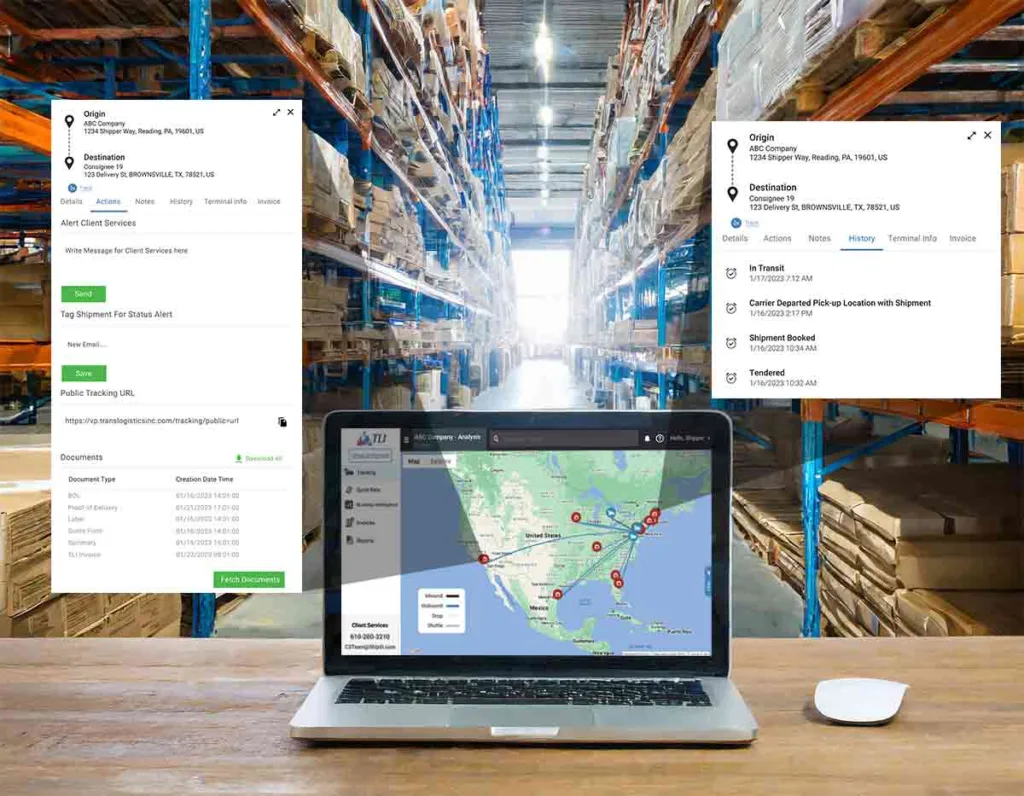6 Strategies for Shippers
Efficiency is no longer a choice but a necessity.

The back office transportation administration, often underestimated, plays a central role in operational effectiveness. This white paper delves into six essential methods to fortify efficiency within this vital segment of your enterprise:
- Incorporating technology rollout plans into strategic planning sessions
- Engaging in freight audits either internally or with specialized partners
- Gathering historical shipment data
- Prioritizing data visibility
- Integrating TMS with ERP systems
- Automating routine tasks like load tendering and pickup requests.
Implementing these strategies will unveil fresh efficiencies, granting your organization a competitive edge in the dynamic, ever-evolving freight landscape.
Incorporating TMS Technology Rollout Plans in Strategic Planning Sessions
TMS Technology Strategy
Technology serves as a potent tool for amplifying back office efficiency. Each year, it brings forth fresh advancements in artificial intelligence, innovative software, and seamless integrations promising swifter and simpler processes. However, why do things not always unfold as expected?
Often, companies hastily undertake technology overhauls without considering the potential impact on back office efficiency. While new software systems and platforms may promise long-term efficiency gains, they can also disrupt operations in the short term. Shippers must develop a well-crafted TMS technology rollout plan and leverage expert guidance.

Here are some pointers for executing a technology transportation administration rollout that enables your back office to swiftly leverage the benefits of new technology:
- Collaborate with Your Shipping Technology Providers: Partnering with freight brokerage organizations is vital for a successful technology rollout, particularly for seamless integration of platforms and tools. A reliable partner can assist in creating a tailored rollout plan, conducting product testing, and ensuring comprehensive staff training.
- Provide Adequate Training: Inadequate training can lead to pushback, disengagement, and low adoption rates among team members. Comprehensive training facilitates a smoother transition, and continuous availability of training materials aids in ongoing skill development. Incorporating gamification can accelerate staff proficiency with new technology.
- Test Thoroughly Before Launch: Establish a thorough testing plan to identify and address issues prior to launch. Utilize various testing methods such as pilot testing, integration testing, and user acceptance testing, and meticulously document testing results to facilitate prompt updates by the responsible parties.
- Communicate Early and Often: Transparent communication with the back office team prior to technological changes is crucial to mitigate stress associated with sudden changes. Clearly articulate the rollout process, elucidate the benefits of the technology, and provide avenues for staff to express queries or concerns. Additionally, communicate any changes or upgrades promptly to facilitate troubleshooting or enhanced vigilance.
By following these strategies, your back office can effectively harness the potential of new TMS technology, fostering efficiency and productivity within your organization.
Engaging in freight audits either internally or with specialized partners
Perform regular freight audits.
Conducting freight rate audits and reviewing freight bills for accuracy, confirming charges, and ensuring proper billing, are all essential for the success of back office operations. With up to 10% of freight bills containing errors, the consequences can be significant:
- Delayed payments and extended days sales outstanding (DSO)
- Diminished credibility
- Incorrect charges
- Misdirected deliveries
- Dissatisfied customers
Consistent auditing leads to faster payment processing, promoting a more predictable and timely cash flow. This transportation administration process not only alleviates financial strain but also facilitates improved financial planning. When transportation administration is rolled out properly it enables stability and flexibility for transportation and logistics providers in managing their operations. Accurate invoices are fundamental for smooth transactions and enhanced cash flow management.

By proactively identifying and rectifying errors, carriers not only avoid costly mistakes but also nurture positive client relationships. This approach fosters trust and reliability, essential for fostering long-term partnerships and sustainable business growth in the competitive logistics industry.
Beyond safeguarding customer relationships, providers can protect their bottom line through auditing bills before invoicing for accessorial charges such as reconsignment, detention, reclassification, or special handling. This ensures fair compensation for services rendered and helps preserve the value proposition.
Moreover, audits can unveil valuable opportunities, such as identifying lucrative shipper relationships and areas for operational enhancement. This empowers providers to refine service delivery and maintain competitiveness in the market. Delivering accurate and transparent billing not only enhances operational efficiency but also serves as a potent competitive advantage, setting providers apart in a crowded marketplace and attracting potential clients seeking reliability and trustworthiness.
Regrettably, freight rate auditing often falls by the wayside for back office teams overwhelmed by the escalating volume of daily tasks. Many companies address this challenge by outsourcing the audit process to reputable business process outsourcing (BPO) and technology providers.
Gathering historical shipment data
While structured data follows organized formats, unstructured data lacks predefined organization, often presenting in varied formats that challenge computer extraction and utilization.
In the freight industry, unstructured data resides in shipping documents, spreadsheets, emails, and PDFs. The abundance of unstructured data often leads companies into a state of “data paralysis,” inundated with data that offers no clear insights, hindering informed decision-making, without data transportation administration can not be benchmarked nor quantitatively improved.
However, despite its complexity, unstructured data holds significant value. It can:
- Complement structured data for deeper insights.
- Provide insights into variables like weather, traffic, and supply chain disruptions, enhancing logistics management efficiency.
- Shape new service offerings based on customer sentiment and behavior.
- Offer insights into operational patterns and bottlenecks, facilitating the identification of inefficiencies and optimization opportunities.
According to the MIT Sloan School of Management, approximately 80-90% of data is unstructured, representing a vast resource for improving efficiency if processed effectively.
Utilizing data extraction technology, such as Meet ViewPoint TMS, enables swift extraction of historical shipment data into spreadsheets or structured dashboards through Microsoft PowerBI integration. Leveraging the right technology, like mobile data capture, is crucial for effective data extraction.
Machine learning tools, such as Viewpoints Auto-Extraction can provide unstructured data while the Microsoft Power BI dashboard offers structuring solutions, which can be trained to capture, organize, and analyze unstructured data in real-time dashboards, understanding its context and transferring key insights into chosen databases or software applications. This automation drastically reduces manual effort, labor costs, and human error while enhancing efficiency, accuracy, and decision-making.
Furthermore, effective tools and software integrate seamlessly with your existing tech stack, facilitating efficient information exchange among all systems. This alignment ensures streamlined operations and maximizes the benefits of data utilization.
Integrating TMS with ERP systems
Integrate your systems!
The majority of manufacturing and distribution companies rely on numerous software applications, sometimes numbering in the dozens or even hundreds. Ideally, your back office technology stack should enhance productivity and efficiency. However, frequently these systems operate independently, lacking integration. The consequence? A disjointed workflow necessitating manual data entry, resulting in errors, data silos, inefficiencies, and suboptimal resource allocation.

When your back office team is compelled to manually input data from one platform to another, the risk of human error escalates. This can subsequently impede your processes and affect your cash flow, as illustrated in the following example:
No Integration:
- Software Application receives an order
- Back off staff manually copies data into bulling platform, and TMS to crate the bill of lading. (Perhaps two separate employees increasing odds of unknowingly making an error.)
- Back office bills client based off incorrect data.
- Client disputes bill
- Back office reviews invoice, manually finds error and rekeys the data.
- Perhaps disputes charges manually with the carrier.
- Back office issues a corrected invoice (potentially writing off their internal error), client pays or disputes invoice.
- Problem is amplified with reclasses and reweighs when not using the proper technology, because there is no built-in rating engine, automated NMFC classification, and freight class retrieval, PCF/Density Calculator.
Integration:
- Order is automatically sent to ERP which generates the bill of lading and client invoice, already GL coded.
- Integration automatically tenders the pickup request to the carrier.
- Back office bills client.
- Client pays invoice.
The solution to most shippers is integrating TLI’s ViewPoint Transportation Management System with their ERP. This integration offers substantial advantages for your back office operations. In the freight industry, legacy systems are still prevalent, yet they often lack compatibility with newer applications straight out of the box.
These integrations yield several benefits, including:
- Enhanced Resource Allocation: By automating communication between systems, your back office team eliminates the need for manual data re-entry across platforms. This not only reduces errors but also minimizes time spent on rectifying mistakes and handling billing inquiries and invoice disputes. The newfound efficiency allows staff to focus on other essential tasks.
- Increased Agility: Integrated systems provide your back office and leadership teams with rapid access to accurate data, enabling informed decision-making based on real-time information. This fosters a culture of continuous improvement and promotes a more agile business model. Access to actionable data facilitates the tracking of metrics and progress towards set goals.
Integrations serve as a vital link, bridging older systems with modern ones, enabling continued utilization of legacy platforms that suit your organization’s needs, thus avoiding a complete overhaul of your tech stack.
Automating transportation administration tasks like load tendering and pickup requests.
Automate routine tasks
Relying on manual processes can consume significant back office hours and introduce errors and delays in routine tasks like freight billing, data entry, and report generation. These disruptions not only impact your operations but also affect your clients.
Automating repetitive and mundane tasks offers several transportation administration benefits, including:
- Enhanced Customer Experience: Automation improves data accuracy and processing speed, leading to positive outcomes for both your company and your clients. Faster delivery, smoother payment processes, and the ability to allocate more resources to customer service contribute to an improved customer experience.
- Accelerated Cash Flow: Automated systems streamline crucial documentation processing, resulting in faster and more accurate transactions. This speed, particularly in freight bill processing, helps reduce days sales outstanding (DSO) in your accounts receivables (AR) department, ensuring prompt payment for your organization.
- Business Continuity: The freight industry is prone to fluctuations such as supply chain disruptions, talent shortages, and rapid shifts in demand. Manual, repetitive tasks hinder scalability and responsiveness to industry changes. Automating tasks like budgeting and forecasting, based on historical data, not only accelerates these processes but also facilitates easier adaptation to industry changes and organizational growth. This adjustment occurs without neglecting revenue-building tasks or risking burnout among your team.
Approaching Automation
How to launch an automated solution.
Choosing the appropriate tools and software to automate tasks within your organization begins by identifying which tasks warrant automation. Look for tasks that:
- Require frequent completion
- Follow predictable, rule-based patterns (consistently performed in the same manner)
- Are prone to human error
- Consume a significant amount of time
Once you’ve pinpointed the tasks for automation, it’s crucial to explore your technology options. In addition to assessing the basic functionality of each solution, consider the following factors:
- Change Management:
- Is the solution user-friendly and intuitive?
- How much preparation and training are necessary for effective implementation?
- Integration:
- Does the solution seamlessly integrate with your existing tech stack?
- Is it easy or challenging to create custom integrations?
- Customization:
- To what extent can you tailor the solution to meet your specific requirements and workflows?
- Scalability:
- Does the solution align with your long-term business objectives?
- Will it remain effective as your organization undergoes significant growth?
- Security:
- How robust is the solution’s security measures?
- What measures are in place to prevent unauthorized access and safeguard sensitive data?
Each organization is unique, necessitating the selection of an approach that aligns with its technology infrastructure, budgetary constraints, and long-term objectives. The point-to-point approach is optimal when dealing with a limited number of applications; however, excessive communication between numerous apps can impede the flow of information. Conversely, for larger or more intricate tech stacks, the middleware approach offers greater efficiency and scalability.

While some software solutions offer built-in integrations, custom integrations may be required depending on your specific tech stack, and business rule automation expectations. This TMS integration process can be intricate and resource-intensive, underscoring the importance of collaborating with your technology providers or a reputable BPO partner to establish seamless system connections efficiently.
Keeping Pace with the Competition
Utilizing advanced technologies such as artificial intelligence and machine learning (e.g., OCR), predictive analytics, natural language processing (NLP), and generative AI, along with specialized software, presents freight companies with unprecedented opportunities to enhance their back office efficiency. Failure to stay abreast of the continually evolving industry standards poses the risk of lagging behind competitors.
By automating mundane tasks, integrating systems, emphasizing data visibility, extracting unstructured data, conducting routine freight rate audits, and proactively planning for technology rollouts, you can elevate your transportation administration back office efficiency, leading to improved business outcomes in the long run.
About TLI
Translogistics Inc., known as ‘TLI’, (trust, loyalty, integrity) stands as an acclaimed freight broker recognized for its steadfast dedication to excellence in logistics solutions. Renowned as a trusted partner for shippers, TLI offers unparalleled expertise in:
- Transportation RFPs
- Supply chain analytics
- Managed Transportation
- Seamless integration of our ViewPoint TMS software with Shippers ERP systems.
Since our establishment in 1994, we have provided comprehensive multi-modal support, ranging from Parcel, LTL, and truckload to specialty equipment such as hot shot goosenecks, conestoga, curtain side, and flatbed support. TLI also extends freight invoice audit services and boasts a Transportation Management System that shippers across the country are wisely integrating into their operations.
Our extensive industry experience, coupled with a forward-thinking approach, enables us to deliver optimized, cost-effective solutions tailored to each client’s unique supply chain needs. At TLI, we take pride in cultivating robust partnerships that empower businesses to streamline operations and maximize efficiency across their entire operation. Beyond freight management, TLI excels in gathering supply chain analytics.
Integrating this shipment data into your ERP or leveraging Microsoft PowerBI for comprehensive insights, partnering with TLI ensures the delegation of burdensome tasks, facilitating smoother operations and providing actionable analytics for data-driven decision-making.